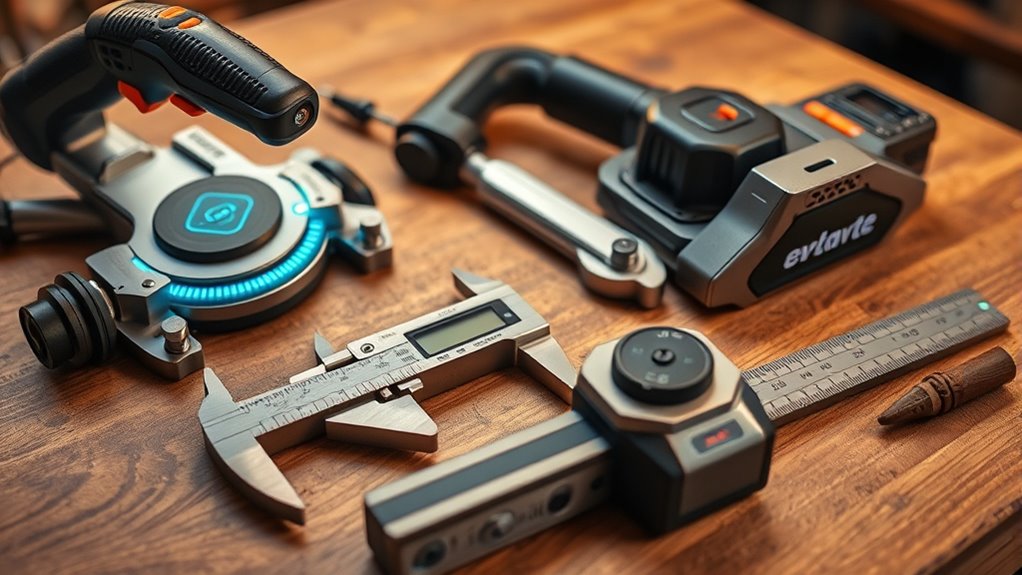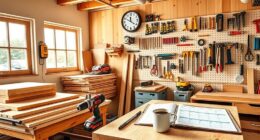Innovations in woodworking tools are transforming your projects with battery-powered devices, offering greater portability and power that rival traditional corded tools. Digital fabrication, like CNC routers, lets you achieve high-precision cuts and complex designs more easily. Advanced tooling with carbide tips increases durability, while sustainable materials and eco-friendly finishes help you work responsibly. Smart furniture features, such as embedded lighting and wireless charging, blend craftsmanship with modern technology. Exploring these trends will give you a glimpse of what’s shaping the future of woodworking.
Key Takeaways
- Battery-powered tools offer increased portability, power, and safety, replacing traditional corded options in woodworking projects.
- CNC machines and digital fabrication enable precise, complex designs, expanding creative possibilities for hobbyists and professionals.
- Advancements in carbide tooling and insert bits improve durability, efficiency, and ease of maintenance across woodworking equipment.
- Sustainable materials like Cross-Laminated Timber and eco-friendly finishes support environmentally conscious woodworking practices.
- Modern furniture integrates wireless charging, smart features, and mixed materials, blending craftsmanship with digital innovation.

Woodworking tools are continually evolving, driven by advances in technology and a focus on safety, efficiency, and sustainability. You’ll notice that battery-powered tools are increasingly replacing traditional corded options, offering greater portability and convenience whether you’re working in a workshop or on-site. Cordless benchtop tools like miter saws and routers are now popular, once only found as handheld devices, but now designed to provide stability and power.
Battery-powered woodworking tools are replacing cords, offering greater portability, stability, and convenience for workshop and on-site projects.
The Hilti SM 60-22 cordless miter saw exemplifies this shift, combining a compact form with easy angle adjustments to boost your cutting efficiency. Thanks to improvements in battery technology, these cordless tools can deliver power and precision comparable to their corded counterparts, making them reliable for demanding tasks. The key benefits are portability and safer handling, reducing clutter and minimizing trip hazards, which is why more woodworkers prefer battery-powered equipment.
Meanwhile, CNC machines are transforming how you approach complex projects. These advanced routers automate tasks like cutting, shaping, and drilling with high precision, allowing you to produce intricate and repeatable designs. CNC technology is becoming more accessible to hobbyists, enabling you to carve detailed 3D shapes that go beyond flat surfaces, opening up new creative possibilities.
You’ll find CNC machines used in crafting furniture, signs, musical instruments, boats, and prefab structures, streamlining production and ensuring consistency. Additionally, early-stage 3D printing is beginning to play a role, enabling you to produce custom joints and decorative elements with ease. These innovations substantially boost efficiency, letting you focus more on design and craftsmanship rather than manual labor. Incorporating digital fabrication into your workshop can further elevate your projects by integrating multiple modern techniques.
When it comes to tooling, carbide-tipped bits and blades are game-changers. They provide long-lasting sharpness and durability, particularly suited for tough materials. Insert tooling with replaceable carbide teeth in jointers and planers simplifies maintenance—rotating or replacing individual teeth is quicker and easier than resetting traditional knives.
This upgrade not only improves workflow but also extends tool life. While initial costs are higher, investing in carbide tooling reduces downtime and maintains consistent quality over time, making it a smart choice for professional and serious hobbyist woodworkers alike.
In the domain of materials, sustainability is now a top priority. Cross-Laminated Timber (CLT) offers a strong, eco-friendly alternative to traditional wood, favored for its durability. New environmentally friendly treatments and finishes minimize chemical use while boosting performance, aligning with your desire to build greener.
Many projects now incorporate recycled or alternative wood sources, reducing environmental impact and promoting sustainable practices. This shift influences your material choices and design options, reflecting a broader market demand for eco-conscious woodworking.
Finally, technology is integrating into furniture and home features. Smart elements like wireless charging, touch-activated storage, and embedded LED lighting are increasingly common, blending traditional craftsmanship with modern digital functionality.
These innovations cater to consumers seeking multifunctional, tech-savvy home furniture. Coupled with mixed-material and modular designs, such as combining wood with metal or glass, these trends enable you to craft pieces that are both stylish and highly functional, meeting the evolving needs of modern living.
Conclusion
As you embrace these innovations, you’ll find woodworking becoming easier and more precise than ever. Keep an eye on smart tools and cordless options—they’ll transform your craftsmanship, much like the trusty chisel did centuries ago. Remember, every tool upgrade is a step forward, turning your workshop into a place of creativity and mastery. Don’t let the future pass you by—grab these innovations now and craft your legacy, just like the artisans of old who shaped history with simple, yet powerful tools.









